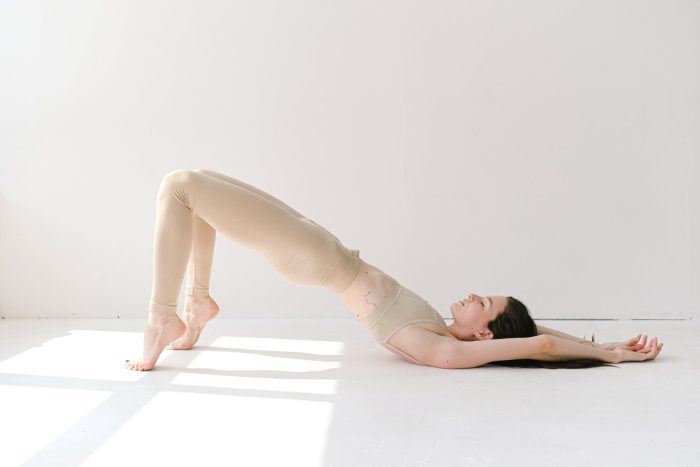“As I often tell my students, the two most important phrases in therapy, as in yoga, are “Notice that” and “What happens next?” Once you start approaching your body with curiosity rather than with fear, everything shifts.” ― Bessel A. van der Kolk
When I started practicing yoga (Ashtanga Vinyasa, to be specific) to make my nervous system feel safe, I would feel like falling onto the ground and just curl up and cry. I realized (over time) that my brain perceived this as an extreme threat (including the fact that I was using a lot of my lower body). But what I also realized is precisely what Bessel A. van der Kolk said — I was curious to know the pattern; what happens after I slump onto the floor and cry; what happens to my breath; what happens to my nerves; what do I feel; how long does it last; where is this coming from; and ultimately what will make me (my nervous system) feel safe.
Eventually, I moved on to other forms of yoga (Kundalini) and Meditation that gave me perspective and a vast opportunity to befriend my breath. But now, we must come to this magical form of one of the many children of yoga called Pilates and how this beauty helps you slowly and steadily release the stress lodged in so many parts of your body.
Pilates is a super way to aid your trauma-healing journey. Strengthening the core is primary in Pilates, and the emphasis it pays to breath work. I have been in awe of this method, and how I love my body, my breath, and the world it opens up to feel my feelings. I specifically practice Wall Pilates or Wall-Unit Pilates because this is best if you suffer from knee, ankle, or back injuries. Do I still feel the same when I do Pilates (like when I practiced Ashtanga Vinyasa Yoga)? Yes, I do, but I handle my body and soul with so much kindness and knowledge this time.
What is Pilates or Wall Pilates?
For those yet to experiment with Pilates or its variation called Wall Pilates or Wall-Unit Pilates, here is a little knowledge I’d like to share.
Pilates is a form of exercise developed in the early 20th century by Joseph Pilates. It improves physical strength, flexibility, posture, and overall body awareness. The Pilates method emphasizes the mind-body connection, controlled movements, and proper breathing techniques. It is often practiced on a mat or using specialized equipment like the reformer, Cadillac, and chairs.
Wall Pilates, also known as Wall-Unit Pilates or Pilates Wall, is a variation of traditional Pilates that incorporates a wall-mounted apparatus. The wall unit typically includes bars, straps, and other attachments that allow for a wide range of exercises to be performed in a vertical or horizontal plane against the resistance of the wall. In Wall Pilates, you typically use your body weight and the resistance provided by the wall to engage and strengthen various muscle groups. The division offers support and stability, making it suitable for people of different fitness levels and those working through physical challenges or injuries.
The benefits of Wall Pilates are similar to those of traditional Pilates, including improved core strength, flexibility, balance, and body awareness. The vertical nature of the exercises can add a new dimension to the workout, targeting different muscles and allowing for a unique range of movements compared to activities performed solely on the mat or traditional Pilates equipment. Like traditional Pilates, Wall Pilates emphasizes the importance of alignment, proper breathing, and a mind-body connection to enhance overall well-being. It can be practiced in group class settings and one-on-one sessions with a certified Pilates instructor (at home too).
For several reasons, Pilates, including Wall Pilates, can be a valuable component of the trauma-healing journey. While it is essential to note that Pilates is not a substitute for professional trauma therapy, it can complement therapeutic interventions and contribute to your overall well-being.
Let’s dive into the five most precious ways Pilates or Wall Pilates aids your trauma-healing journey:
Helps identify and release stress in the core
Trauma can take a toll on your body, leading to tension, pain, and decreased flexibility. When trauma is too difficult to process in the mind, we store it in the body. Typically, it gets stored in the psoas – a deep-seated core muscle that connects the lumbar vertebrae to the femur. The psoas is responsible for the flight or fight and freeze responses in the body. Pilates focuses on releasing, mobilizing, and strengthening the core muscles. It is a great way to reset the psoas and unravel tension patterns in the core. Pilates exercises focus on strengthening the core, improving flexibility, and enhancing overall body strength. This can alleviate physical symptoms associated with trauma and improve overall physical well-being.
Nurtures mindfulness through the mind-body connection
Pilates emphasizes the mind-body connection, encouraging you to focus on breathing, alignment, and mindful movement. This can help you become more aware of your body, sensations, and emotions. By cultivating this awareness, you may better understand and manage trauma’s physical and emotional effects. Trauma can leave us feeling anxious, unable to focus, and on edge. Pilates is a great way to calm the mind and bring our attention to the present. Practicing Pilates with a wandering mind is challenging, as the movements require us to isolate different muscle groups and work them mindfully. At the core of this form is to enable you to notice each movement’s sensations and coordinate with specific breathing patterns. Body, breath, and attention are in sync and can create a meditative state.
Regulates the nervous system
Trauma can lead to dysregulation of the nervous system, resulting in heightened anxiety, hypervigilance, or dissociation. Pilates, mainly when practiced mindfully and at a controlled pace, can aid in regulating the autonomic nervous system. Focus on breathing and smooth movements may help reduce stress and promote a sense of calm. Pilates studios often provide a supportive and non-judgmental environment. Instructors are trained to create a safe space for participants. When you are on your trauma-healing path, this environment can foster a sense of safety and empowerment, allowing you to explore movement at your own pace and comfort level. You can also do this at home but with proper instructions and guidance.
Promotes body awareness and sensation tolerance
Trauma can lead to dissociation or a disconnection from the body. Through Pilates, you can gradually rebuild your connection with your body. This process can help you feel more grounded and in control of your physical experiences, supporting your healing journey. Pilates is empowering as it reminds us of how our body works, how strong it is, and how resilient it can be. Classes often start with body awareness exercises. Just like Breathing Meditation and Mindfulness practices, you have to scan your body and take note of the sensations you feel. Paying attention to the signals your body sends can be a significant first step to reconnecting with your body.
Promises resilience and empowerment
As you progress in your Pilates practice, you may experience a sense of accomplishment and increased self-esteem. Achieving small milestones in movement and witnessing progress can empower and build resilience, crucial for trauma recovery and post-traumatic growth. Participating in group Pilates classes can provide social support and a sense of community. Engaging with others with similar challenges or goals can be comforting and help you feel less isolated in your trauma-healing journey.
If you are new to this form, communicate with your instructor about your needs and boundaries to ensure a positive and safe experience. Instructors ideally should be aware of trauma-sensitive teaching methods and avoid triggering movements or language. If you choose to do this at home, on your own, you must have at least some experience with Pilates or speak to someone who can guide you through it. There are plenty of videos on the internet with trainers who are trauma-informed and are absolutely certified to handle your questions.
Remember, trauma healing is a complex and individualized process, and what works for one person may not work for another. While you need professional guidance from trauma-informed therapists, this healing journey is about you, it’s for you, and it’s yours. So be kind and begin your journey today. It is a lifelong journey.
Suggestion: Combine Pilates or Wall Pilates with Meditation (any form) and breath work. Like any other alternative form of therapy, pay attention to the signals from your body. Do it at your pace, in your own time, with no deadlines or expiration dates. This is going to be with you for life. I practice a form of Wall-Pilates where I use minimal equipment (ankle weights and dumbbells) without a wall unit, and I focus a lot on my body movement and breath so that the equipment does not come in the way. And that’s me. So, the bottom line, you decide what you want to do and how you want to do it. And remember, you know you are on your healing path when you acknowledge your triggers and your feelings and sit them.
May you have an abundance of revelations through your healing journey.












Read 1 comment and reply